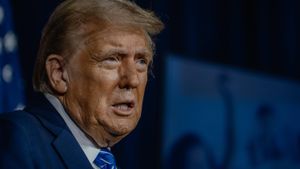A significant shift has occurred within the tech sphere as Chinese giant Huawei has unveiled its newest smartphone, the Mate 70, showcasing the company’s resilience and innovation amid a backdrop of geopolitical strife and technological challenges. This launch not only marks the introduction of cutting-edge hardware but also signifies Huawei's ambitious venture to disentangle itself from U.S. technologies, which have hampered its growth since the onset of severe sanctions.
On Tuesday, Huawei Holdings Ltd. introduced its Mate 70 series, highlighted by state-of-the-art features including its proprietary HarmonyOS Next and advanced 5G chipset crafted entirely within China. This transition away from widely used systems like Android to its own operating system reflects a pivotal moment for Huawei as it seeks to bolster its market presence and reclaim ground lost to competitors like Apple.
During the launch event held at Huawei's headquarters in Shenzhen, Richard Yu, CEO of Huawei’s Consumer Business Group, touted the Mate 70 as "the most powerful Mate phone ever," enhancing its appeal with features such as satellite paging capabilities and improved processing power. The phone starts at 5,499 yuan (approximately $758), making it slightly cheaper than Apple’s baseline iPhone 16 model priced at 5,999 yuan, carving out its strategic position within the competitive smartphone market.
Despite Huawei's advancements, the shift from being dependent on Android has not come without its hurdles. The complete departure from the Android ecosystem means all applications will need to be re-engineered for compatibility, presenting both technical and financial challenges to developers globally. There’s still ambiguity over how willing developers would be to invest their resources to adapt existing apps for HarmonyOS Next, especially when some app development costs could run as high as 2 million yuan (around $276,000) for custom adaptations.
"Huawei has the largest user base in China, but it’s still going to be difficult to get international developers on board," noted Rich Bishop, co-founder and CEO of AppinChina. Huawei recognizes the uphill battle it faces as it calls for more developers to embrace its operating system, pledging extensive training and support to help onboard them. Business analysts suggest Huawei's remarkable recovery within China's smartphone sector serves as both motivation and cautionary tale for tech giants globally.
Reviving from the brink, Huawei’s recovery was pointedly catalyzed by the rise of nationalistic sentiment favoring homegrown technology solutions. Researchers from Canalys placed Huawei as the second-largest smartphone vendor by volume within China, reporting over 10 million devices shipped by Q3 2024, which marks a sharp recovery compared to just 4.1 million units shipped during Q2 of 2022. This trend presents hopeful indicators for Huawei, as it aims to drive the Mate 70 series shipments beyond the 10 million mark.
This milestone also resonates with the broader narrative of China's efforts toward tech self-sufficiency, particularly within semiconductor production. Huawei's reliance on Semiconductor Manufacturing International Corp (SMIC) for its Kirin 9100 chip indicates the extent of China's domestic technology ambitions, especially as Western sanctions have created challenging headwinds for advanced chip production. Although challenges persist, including lower chip yield affecting overall production capabilities, Huawei’s determination to forge its own developmental path is unwavering.
Huawei’s non-reliance on U.S. tech not only reflects its strategic repositioning but also aligns with China’s larger economic and technology aspirations amid heightened scrutiny and restrictions from Western nations. Yu highlighted, "We must innovate on our own, and cannot let ourselves be disrupted by foreign countries," signaling Huawei's intent to be at the forefront of national tech self-reliance.
Looking beyond hardware, Huawei's alignment with generative AI functions promises to reshape user interactions through capabilities such as real-time call translation and transcription. This innovative positioning showcases Huawei's significant push toward blending advanced technology with user-friendly applications, aiming to bridge gaps left by other smartphones still grappling with compatibility issues.
Yet, the future is fraught with uncertainties. The viability of the Mate 70 series depends on various external factors, including geopolitical tensions and shifting regulatory landscapes. Should U.S. restrictions tighten, they may impact not only Huawei's operations but the broader equilibrium of trade and technology exchange with China.
Experts view the launch of Huawei’s Mate 70 smartphone series as both a potential renaissance for Huawei and a test bed for the durability of HarmonyOS Next as it seeks to prevail against the entrenched dominance of Android and iOS systems. Whether this ambitious venture can truly divert the user base accustomed to traditional operating systems remains to be seen.
The stakes are particularly high for Huawei, as this smartphone generation cannot afford to miss the mark. With expectations set high by both the consumer market and within the industry, failing to deliver on these advancements may impede Huawei’s continued ascendance within both the domestic and international tech markets.
Huawei's experience with the Mate 70 series will likely serve as the litmus test for China’s broader technological advancements, as it seeks to highlight the economic and innovative prowess available on home soil. The Mate 70 sale may represent one of Huawei's boldest moves yet: to carve out space for itself amid increasingly complex geopolitical landscapes firmly cemented by competitive pressures and international scrutiny.
Additional news outlets have noted varying factors impacting this technological pivot, with some analysts citing production timeline delays and lost access to Google services as historical setbacks. Nonetheless, Huawei's proactive approach targeting developers and consumers alike facilitates broader access to its technologically integrated ecosystem. The call for rapid adaptation from developers appears to be Huawei's strategy, betting on its growing prowess and domestic support to navigate complex waters against competitors like Apple.
On all fronts, the stakes remain high and the outcomes uncertain as Huawei's Mate 70 smartphone series launches amid whispers of potential renewed U.S. sanctions. This could serve as either Huawei's groundbreaking moment or another chapter of obstacles to overcome.



